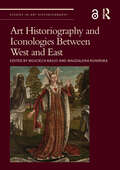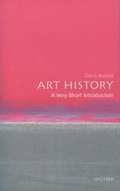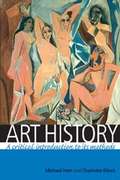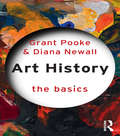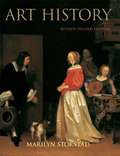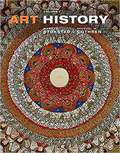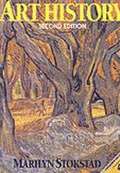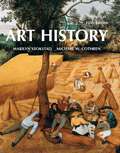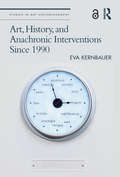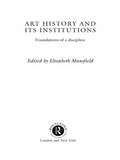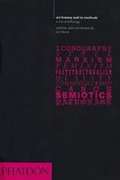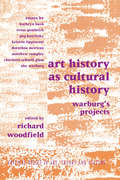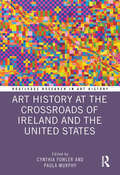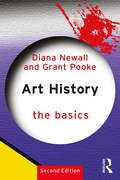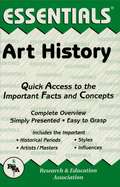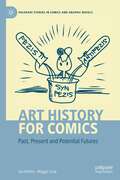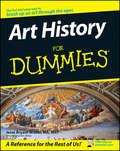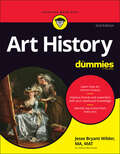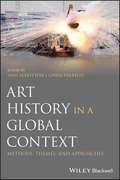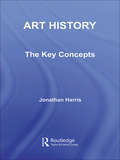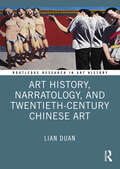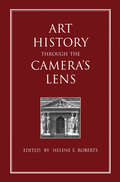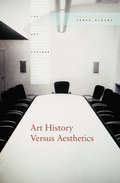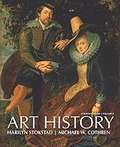- Table View
- List View
Art Historiography and Iconologies Between West and East (ISSN)
by Wojciech Bałus Magdalena KunińskaThis volume explores a basic question in the historiography of art: the extent to which iconology was a homogenous research method in its own immutable right. By contributing to the rejection of the universalizing narrative, these case studies argue that there were many strands of iconology.Methods that differed from the ‘canonised’ approach of Panofsky were proposed by Godefridus Johannes Hoogewerff and Hans Sedlmayr. Researchers affiliated with the Warburg Institute in London also chose to distance themselves from Panofsky’s work. Poland, in turn, was the breeding ground for yet another distinct variety of iconology. In Communist Czechoslovakia there were attempts to develop a ‘Marxist iconology’. This book, written by recognized experts in the field, examines these and other major strands of iconology, telling the tale of iconology’s reception in the countries formerly behind the Iron Curtain. Attitudes there ranged from enthusiastic acceptance in Poland, to critical reception in the Soviet Union, to reinterpretation in Czechoslovakia and the German Democratic Republic, and, finally, to outright rejection in Romania.The book will be of interest to scholars working in art history, visual studies, and historiography.
Art History: A Very Short Introduction
by Dana ArnoldThis clear and concise new introduction examines all the major debates and issues using a wide range of well-known examples. It discusses the challenge of using verbal and written language to analyse a visual form. Dana Arnold also examines the many different ways of writing about art, and the changing boundaries of the subject of art history. Topics covered include the canon of Art History, the role of the gallery, 'blockbuster' exhibitions, the emergence of social histories of art (Feminist Art History or Queer Art History, for example), the impact of photography, and the development of Art History using artefacts such as the altarpiece, the portrait, or pornography, to explore social and cultural issues such as consumption, taste, religion, and politics. Importantly, this book explains how the traditional emphasis on periods and styles originates in western art production and can obscure other critical approaches, as well as art from non western cultures.
Art History: A Critical Introduction to Its Methods
by Michael Hatt Charlotte KlonkThis book provides a lively and stimulating introduction to methodological debates within art history. Offering a lucid account of approaches from Hegel to post-colonialism, the book provides a sense of art history's history as a discipline from its emergence in the late-eighteenth century to contemporary debates. By explaining the underlying philosophical and political assumptions behind each method, along with clear examples of how these are brought to bear on visual and historical analysis, the authors show that an adherence to a certain method is, in effect, a commitment to a set of beliefs and values. The book makes a strong case for the vitality of the discipline and its methodological centrality to new fields such as visual culture. This book will be of enormous value to undergraduate and graduate students, and also makes its own contributions to ongoing scholarly debates about theory and method.
Art History: Teach Yourself Ebook (The Basics)
by Diana Newall Grant PookeArt History: The Basics is a concise and accessible introduction for the general reader and the undergraduate approaching the history of art for the first time at college or university. It will give you answers to questions like: What is art and art history? What are the main methodologies used to understand art? How have ideas about form, sex and gender shaped representation? What connects art with psychoanalysis, semiotics and Marxism? How are globalization and postmodernism changing art and art history? Each chapter introduces key ideas, issues and debates in art history, including information on relevant websites and image archives. Fully illustrated with an international range of artistic examples, Art History: The Basics also includes helpful subject summaries, further ideas for reading in each chapter, and a useful glossary for easy reference.
Art History
by Marilyn Stokstad David Cateforis Stephen AddissIn tune with today's readers--rich but never effete--this is the art history book of choice for a new generation. Presenting a broad view of art through the centuries, it sympathetically and positively introduces the works of all artists. This includes women, artists of color, and the arts of other continents and regions, as well as those of Western Europe and the United States. The new edition contains even more full-color reproductions, larger images, redrawn maps and timelines, and new photographs and higher quality images. Balancing both the traditions of art history and new trends of the present, Art History is the most comprehensive, accessible, and magnificently illustrated work of its kind. Broad in scope and depth, this beautifully illustrated work features art from the following time periods and places: prehistoric art in Europe; ancient art of the Near East, Egypt, the Aegean, and Greece; Roman and Etruscan art; Jewish, early Christian, and Byzantine art; Islamic art; art from ancient India, China, Japan, and the Americas; medieval art in Europe; Romanesque, Gothic, and Renaissance art; Baroque art; art of the Pacific cultures; the rise of modern art; and the international Avant-Garde since 1945. An excellent reference work and beautiful edition for any visual artist.
Art History: Volume 1
by Marilyn Stokstad Michael W. CothrenArt History brings the history of art to life for a new generation of students. It is global in scope, inclusive in its coverage, and warm and welcoming in tone. The guiding vision of Art History is that the teaching of art history survey courses should be filled with equal delight, enjoyment, and serious learning, while fostering an enthusiastic and educated public for the visual arts. The Sixth Edition has been revised to reflect new discoveries, recent research, and fresh interpretive perspectives, as well as to address the changing needs of both students and educators. Art History, Sixth Edition is also available via Revel™, an interactive learning environment that enables students to read, practice, and study in one continuous experience.
Art History (2nd Edition)
by Marilyn Stokstad David CateforisFor two-semester courses in Art History Survey, Global Art History, and for Introductory Art courses taught from a historical perspective. Exceptional in scholarship and pedagogically in tune with the needs of today's students rich but never effete Marilyn Stokstad's Art History is the art history text of choice for a new generation of teachers and students. Presenting a broad view of art through the centuries, it introduces beginning students in a positive and sympathetic manner to the works of all artists. This includes women and artists of color, and the arts of other continents and regions in addition to those of Western Europe and the United States. Balancing both the traditions of art history and new trends of the present, Art History is the most comprehensive, accessible, and magnificently illustrated work of its kind.
Art History (5th Edition)
by Marilyn Stokstad Michael W. CothrenArt History 5th Edition continues to balance formal analysis with contextual art history in order to engage a diverse student audience. Authors Marilyn Stokstad and Michael Cothren, both scholars as well as teachers, share a common vision that survey courses should be filled with as much enjoyment as learning, and that they should foster an enthusiastic, as well as an educated, public for the visual arts. This revision is the strongest and most comprehensive learning program for measuring student progress and improving student success in attaining the outcomes and goals of the art history survey course. Not only does the text address four overarching goals of the survey course, the new MyArtsLab further develops and reinforces these outcomes and skills with market-leading learning tools such as personalized study plans for each student and multimedia assets geared towards addressing different learning styles and abilities, such as chapter audio, student videos, Closer Looks, architectural panoramas and much more. The end result is a complete learning program designed to increase students' success with a personalized, digital and a highly mobile learning experience.
Art, History, and Anachronic Interventions Since 1990 (Studies in Art Historiography)
by Eva KernbauerThis book examines contemporary artistic practices since 1990 that engage with, depict, and conceptualize history. Examining artworks by Kader Attia, Yael Bartana, Zarina Bhimji, Michael Blum, Matthew Buckingham, Tacita Dean, Harun Farocki and Andrei Ujica, Omer Fast, Andrea Geyer, Liam Gillick and Philippe Parreno, Hiwa K, Amar Kanwar, Bouchra Khalili, Deimantas Narkevičius, Wendelien van Oldenborgh, Walid Raad, Dierk Schmidt, Erika Tan, and Apichatpong Weerasethakul, Art, History, and Anachronic Interventions since 1990 undertakes a thorough methodological reexamination of the contribution of art to history writing and to its theoretical foundations. The analytical instrument of anachrony comes to the fore as an experimental method, as will (para)fiction, counterfactual history, testimonies, ghosts and spectres of the past, utopia, and the "juridification" of history. Eva Kernbauer argues that contemporary art—developing its own conceptual approaches to temporality and to historical research—offers fruitful strategies for creating historical consciousness and perspectives for political agency. The book will be of interest to scholars working in art history, historiography, and contemporary art.
Art History and Its Institutions: The Nineteenth Century
by Elizabeth MansfieldArt History and Its Institutions focuses on the institutional discourses that shaped and continue to shape the field from its foundations in the nineteenth century. From museums and universities to law courts, labour organizations and photography studios, contributors examine a range of institutions, considering their impact on movements such as modernism; their role in conveying or denying legitimacy; and their impact on defining the parameters of the discipline.
Art History And Its Methods
by Eric FernieApproaches to the history of art are probably more varied - and more debated than in any other branch of history, and a study of different historical approaches is becoming an increasingly important component of many academic courses. This anthology of art-historical writings from the Renaissance to the present day has a particular focus, for key texts have been chosen in which the authors themselves reflects on the nature of their subject and on their own methods of inquiry. Included are texts by Vasari, Winckelmann, Burckhardt, Wolfflin, Panofsky, Gombrich and Pollock, among others. The introduction gives a summary of art-historical methods, and each of the texts is accompanied by a brief commentary which places it in context and discusses the issues it raises. Also provided is a critical glossary of art-historical terms, a brief biography of each of the historians, and a select bibliography.
Art History as Cultural History: Warburg's Projects (Critical Voices in Art, Theory and Culture)
by Richard WoodfieldThis book focuses on Aby Warburg (1866-1929), one of the legendary figures of twentieth century cultural history. His collection, which is now housed in the Warburg Institute of the University of London bears witness to his idiosyncratic approach to a psychology of symbolism, and explores the Nachleben of classical antiquity in its manifold cultural legacy. This collection of essays offers the first translation of one of Warburg's key essays, the Gombrich lecture, described by Carlo Ginzburg as 'the richest and most penetrating interpretation of Warburg' and original essays on Warburg's astrology, his Mnemosyne project and his favourite topic of festivals. Richard Woodfield is Research Professor in the Faculty of Art and Design at the Nottingham Trent University, England. He has edited E.H Gombrich's Reflections on the History of Art (1987), Gombrich on Art and Psychology (1996), The Essential Gombrich (1996), and a volume on Riegl in the Critical Voices in Art, Theory and Culture series. He is also the General Editor of a new series of books for G+B Arts International, Aesthetics and the Arts. Edited by Richard Woodfield, Research Professor in the Faculty of Art and Design at Nottingham Trent University, UK.
Art History at the Crossroads of Ireland and the United States (Routledge Research in Art History)
by Cynthia Fowler Paula MurphyTaking the visual arts as its focus, this anthology explores aspects of cultural exchange between Ireland and the United States. Art historians from both sides of the Atlantic examine the work of artists, art critics and art promoters. Through a close study of selected paintings and sculptures, photography and exhibitions from the nineteenth century to the present, the depth of the relationship between the two countries, as well as its complexity, is revealed. The book is intended for all who are interested in Irish/American interconnectedness and will be of particular interest to scholars and students of art history, visual culture, history, Irish studies and American studies.
Art History at the Crossroads of Ireland and the United States (Routledge Research in Art History)
by Cynthia Fowler Paula MurphyTaking the visual arts as its focus, this anthology explores aspects of cultural exchange between Ireland and the United States. Art historians from both sides of the Atlantic examine the work of artists, art critics and art promoters. Through a close study of selected paintings and sculptures, photography and exhibitions from the nineteenth century to the present, the depth of the relationship between the two countries, as well as its complexity, is revealed. The book is intended for all who are interested in Irish/American interconnectedness and will be of particular interest to scholars and students of art history, visual culture, history, Irish studies and American studies.
Art History: The Basics (The Basics)
by Diana Newall Grant PookeNow in its second edition, this volume is an accessible introduction to the history of art. Using an international range of examples, it provides the reader with a toolkit of concepts, ideas and methods relevant to understanding art history. This new edition is fully updated with colour illustrations, increased coverage of non-western art and extended discussions of contemporary art theory. It introduces key ideas, issues and debates, exploring questions such as: What is art and what is meant by art history? What approaches and methodologies are used to interpret and evaluate art? How have ideas regarding medium, gender, identity and difference informed representation? What perspectives can psychoanalysis, semiotics and social art histories bring to the study of the discipline? How are the processes of postcolonialism, decolonisation and globalisation changing approaches to art history? Complete with helpful subject summaries, a glossary, suggestions for future reading and guidance on relevant image archives, this book is an ideal starting point for anyone studying art history as well as general readers with an interest in the subject.
Art History Essentials
by George Michael CohenREA's Essentials provide quick and easy access to critical information in a variety of different fields, ranging from the most basic to the most advanced. As its name implies, these concise, comprehensive study guides summarize the essentials of the field covered. Essentials are helpful when preparing for exams, doing homework and will remain a lasting reference source for students, teachers, and professionals. Art History highlights the history of art, from the Ancient World to the Twentieth Century. It includes illustrations and photos of Egyptian architecture, Greek sculpture, and Renaissance paintings and sculpture. This book explains the different art movements such as Baroque and Neoclassicism, and describes the kinds of materials that were used to create the various works. This book is an ideal study aid for students who must familiarize themselves with major works of art, how they were created, and the affect they had on world history.
Art History for Comics: Past, Present and Potential Futures (Palgrave Studies in Comics and Graphic Novels)
by Ian Horton Maggie GrayThis book looks at comics through the lens of Art History, examining the past influence of art-historical methodologies on comics scholarship to scope how they can be applied to Comics Studies in the present and future. It unearths how early comics scholars deployed art-historical approaches, including stylistic analysis, iconography, Cultural History and the social history of art, and proposes how such methodologies, updated in light of disciplinary developments within Art History, could be usefully adopted in the study of comics today. Through a series of indicative case studies of British and American comics like Eagle, The Mighty Thor, 2000AD, Escape and Heartbreak Hotel, it argues that art-historical methods better address overlooked aspects of visual and material form. Bringing Art History back into the interdisciplinary nexus of comics scholarship raises some fundamental questions about the categories, frameworks and values underlying contemporary Comics Studies.
Art History For Dummies
by Jesse Bryant Wilder MA, MATArt history is more than just a collection of dates and foreign-sounding names, obscure movements and arcane isms. Every age, for the last 50,000 years has left its unique imprint on the world, and from the first cave paintings to the ceiling of the Sistine Chapel, from the Byzantine mosaics of the Hagia Sophia, to the graffiti-inspired paintings of Jean-Michel Basquiat, art history tells the story of our evolving notions of who and what we are and our place in the universe.Whether you're an art enthusiast who'd like to know more about the history behind your favorite works and artists, or somebody who couldn't tell a Titian and a De Kooning--but would like to--Art History For Dummies is for you. It takes you on a tour of thirty millennia of artistic expression, covering the artistic movements, major artists, and indispensable masterworks, and the world events and cultural trends that helped spawn them. With the help of stunning black-and-white photos throughout, and a sixteen-page gallery of color images, it covers:The rise and fall of classical art in Greece and RomeThe differences between Renaissance art and MannerismHow the industrial revolution spawned RomanticismHow and why Post-Impression branched off from ImpressionismConstructivism, Dadaism, Surrealism and other 20th century ismsWhat's up with today's eclectic art sceneArt History For Dummies is an unbeatable reference for anyone who wants to understand art in its historical context.
Art History For Dummies
by Jesse Bryant WilderReady to discover the fascinating world of art history? Let’s (Van) Gogh! Fine art might seem intimidating at first. But with the right guide, anyone can learn to appreciate and understand the stimulating and beautiful work of history’s greatest painters, sculptors, and architects. In Art History For Dummies, we’ll take you on a journey through fine art from all eras, from Cave Art to the Colosseum, and from Michelangelo to Picasso and the modern masters. Along the way, you’ll learn about how history has influenced art, and vice versa. This updated edition includes: Brand new material on a wider array of renowned female artists Explorations of the Harlem Renaissance, American Impressionism, and the Precisionists Discussions of art in the 20th and 21st centuries, including Dadaism, Constructivism, Surrealism, and today’s eclectic art scene Is there an exhibition in your town you want to see? Prep before going with Art History For Dummies and show your friends what an Art Smartie you are. An unbeatable reference for anyone looking to build a foundational understanding of art in a historical context, Art History For Dummies is your personal companion that makes fine art even finer!
Art History in a Global Context: Methods, Themes, and Approaches
by Ann Albritton and Gwen FarrellyPresents a clear and comprehensive introduction to the evolving discipline of global art studies This volume examines how art historians, critics, and artists revisit art from ancient times through to the early modern period as well as the ways in which contemporary objects are approached through the lens of global contact, exchange, networks, and trade routes. It assists students who actively seek to understand "global art history" and the discipline beyond the founding Western canons. The first section of Art History in a Global Context: Methods, Themes and Approaches explores how themes related to globalization are framing the creation, circulation, reception, and study of art today. The second section examines how curators, scholars, artists, and critics have challenged the Eurocentric canon through works of art, writings, exhibitions, biennials, large-scale conferences, and the formation of global networks. The third section is designed to help students look forward by exploring how art history in a global context is beginning to extend beyond the contemporary condition to understand the meaning, conditions, and impacts of exchange across borders and among artists in earlier periods. Presents a historiography of global art histories in academic, museological, and exhibition projects Written by a collection of authors from different linguistic, cultural, geographic, generational, and disciplinary perspectives Aids students in understanding “global art history” and the discipline beyond the founding Western canons Provides a set of case studies to bring to life methodologies being employed in the field Features contributors from the program of the Getty Foundation and the College Art Association International Committee’s project Art History in a Global Context is an ideal choice for upper-level undergraduate and entry level graduate art students. It can also be used as a teaching tool, or as models for case studies in different formats.
Art History: The Key Concepts (Routledge Key Guides)
by Jonathan HarrisArt History: The Key Concepts is a systematic, reliable and accessible reference guide to the disciplines of art history and visual culture. Containing entries on over 200 terms integral to the historical and theoretical study of art, design and culture in general, it is an indispensable source of knowledge for all students, scholars and teachers. Covering the development, present status and future direction of art history, entries span a wide variety of terms and concepts such as abstract expressionism, epoch, hybridity, semiology and zeitgeist. Key features include: a user-friendly A-Z format fully cross-referenced entries suggestions for further reading. Engaging and insightful, as well as easy to follow and use, Art History: The Key Concepts builds a radical intellectual synthesis for understanding and teaching art, art history and visual culture.
Art History, Narratology, and Twentieth-Century Chinese Art (Routledge Research in Art History)
by Lian DuanThis study constructs a framework of narratology for art history and rewrites the development of twentieth-century Chinese art from a narratological perspective. Theoretically and methodologically oriented, this is a self-reflective meta-art history studying the art historical narratives while narrating the story of modern and contemporary Chinese art. Thus, this book explores the three layers of narrative within the narratological framework: the first-hand fabula, the secondary narration, and the tertiary narrativization. With this tertiary narrativization, the reader-author presents three types of narrative: the grand narrative of the central thesis of this book, the middle-range narrative of the chapter theses, and case analyses supporting these theses. The focus of this tertiary narrativization is the interaction between Western influence on Chinese art and the Chinese response to this influence. The central thesis is that this interaction conditioned and shaped the development of Chinese art at every historical turning point in the twentieth century. The book will be of interest to scholars working in art history, critical theory, Chinese studies, and cultural studies.
Art History Through the Camera's Lens (Documenting the Image #Vol. 2.)
by Helene E. RobertsPhotography of art has served as a basis for the reconstruction of works of art and as a vehicle for the dissemination and reinterpretation of art. This book provides the first definitive treatment of the subject, with essays from noted authorities in the fields of art history, architecture, and photography. The essays explore the many meanings of photography as documentation for the art historian, inspiration for the artist, and as a means of critical interpretation of works of art. Art History Through the Camera's Lens will be important reading for students, historians, librarians, and curators of the visual arts.
Art History Versus Aesthetics (The Art Seminar #Vol. 1)
by James ElkinsIn this unprecedented collection, over twenty of the world's most prominent thinkers on the subject including Arthur Danto, Stephen Melville, Wendy Steiner, Alexander Nehamas, and Jay Bernstein ponder the disconnect between these two disciplines. The volume has a radically innovative structure: it begins with introductions, and centres on an animated conversation among ten historians and aestheticians. That conversation was then sent to twenty scholars for commentary and their responses are very diverse: some are informal letters and others full essays with footnotes. Some think they have the answer in hand, and others raise yet more questions. The volume ends with two synoptic essays, one by a prominent aesthetician and the other by a literary critic. This stimulating inaugural volume in the Routledge The Art Seminar series presents not one but many answers to the question; Does philosophy have anything to say to art history?
Art History, Volume 2
by Marilyn Stokstad Michael CothrenART HISTORY provides students with the most student-friendly, contextual, and inclusive art history survey text on the market. These hallmarks make ART HISTORY the choice for instructors who seek to actively engage their students in the study of art. This new edition of ART HISTORY is the result of a happy and productive collaboration between two scholar-teachers (Marilyn Stokstad and Michael Cothren) who share a common vision that survey courses on the history of art should be filled with as much enjoyment as erudition, and that they should foster an enthusiastic, as well as an educated, public for the visual arts. Like its predecessors, this new edition seeks to balance formal and iconographic analysis with contextual art history in order to craft interpretations that will engage a diverse student population. Throughout the text, the visual arts are treated as part of a larger world, in which geography, politics, religion, economics, philosophy, social life, and the other fine arts are related components of a vibrant and cultural landscape.
